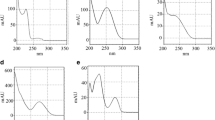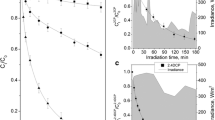Abstract
Background
The photolysis of pesticides is of high current interest since light is one of the most important abiotic factors which are responsible for the environmental fate of these substances and may induce their conversion into noxious products. The action of light can also be mediated by oxygen and synthetic or naturally occurring substances which act as sensitizers. Our objective in this study was to investigate the photochemical behaviour of the systemic fungicide furalaxyl in the presence of oxygen and various sensitizers, and to compare the toxicity of the main photoproduct(s) to that of the parent compound. Previous reports on the direct potolysis of the pesticide demonstrated a very slow degradation and the only identified photoproducts were N-2,6-xylyl-D,L-alaninate and 2,6-dimethylaniline.
Methods
Solutions of furalaxyl in CH3CN were photooxygenated using a 500W high-pressure mercury lamp (through a Pyrex glass filter, »>300 nm) or a 650W halogen lamp or sunlight and the proper sensitizer. When sunlight was used, aqueous solutions were employed. The photodegradation was checked by NMR and/or GC-MS. The photoproducts were spectroscopically evidenced and, when possible, isolated chromatographically. Acute toxicity tests were performed on the rotifer Brachionus calyciflorus, the crustacean cladoceran Daphnia magna and the anostracan Thamnocephalus platyurus, while chronic toxiciry tests (sublethal endpoints) comprised a producer, the alga Pseudokirchneriella subcapitata and the crustacean Ceriodaphnia dubia, as a consumer.
Results and Discussion
In the presence of both oxygen and sensitizer, furalaxyl underwent rapid photochemical transformations mainly to N-disubstituted formamide, maleic anhydride and a 2(5H)-furanone derivative. The formation of these products was rationalized in terms of a furan endoperoxide intermediate derived from the reaction of furalaxyl with active dioxygenated species (singlet oxygen, superoxide anion or ground state oxygen). The 2(5H)-furanone exhibited a higher toxicity than the parent compound.
Conclusion
This work reports the first data on the photosensitized oxygenation of furalaxyl with evidence of the high tendency of the pesticide to undergo photodegradation under these conditions leading, among other things, to a 2(5H)-furanone, which is more toxic than the starting furalaxyl towards aquatic organisms.
Recommendations and Outlook
Investigation highlights that the photolytic fate of a pesticide, although quite stable to direct photoreaction due to its low absorption of solar radiation at ground level, can be significantly influenced in the environment by the presence of substances with energy or electron-transfer properties as natural dyes, e.g. chlorophyll, or synthetic pollutants, e.g. polycyclic aromatic hydrocarbons (PAH).
Similar content being viewed by others
References
Burrows HD, Canle ML, Santaballa JA, Steenken S, (2002): Reaction pathways and mechanisms of photodegradation of pesticides. J Photochem Photobiol B: Biol. 67: 71–108
Tsao R, Eto M, (1994): Effect of Some Natural Photosensitizers on Photolysis of Some pesticides. In: Helz GR, Zepp RG, Crosby DG (eds), Aquatic and Surface Photochemistry, Lewis, London, GB, pp 163–171
Legrini O, Oliveros E, Braun AM (1993): Photochemical processes for water treatment. Chem Rev 93: 671–698
Iesce MR, Cermola F, De Lorenzo F, Graziano ML, Caliendo B, (2002): Photochemical Behaviour of the Systemic Fungicide Carboxin. ESPR - Environ Sci & Pollut Res 9: 107–109
Iesce MR, Graziano ML, Cermola F, Montella S, Di Gioia L, Stasio C, (2003): Effects of Sensitizers on the Photodegradation of the Systemic Fungicide Triadimenol. Chemosphere 51:163–166
Rouchaud J, Metsue M, Benoit F, Ceustermans N, Vanachter A, (1989): Fate of the fungicide furalaxyl in the nutrient solution of tomato crops by the nutrient film technique. J Agric Food Chem 37: 492–495
Pirisi FM, Cabras P, Garau VL, Melis M, Angioni A, Bollita D, (1996): Photodegradation pesticides. 1. Photolysis rates and half-life of acylanilides and their major metabolites in water. Toxicol Environ Chem 55:199–214
Miranda MA, Garcia H, (1994): 2,4,6-Triphenylpyrylium tetrafluoroborate as an electron transfer photosensitizer. Chem Rev 94: 1063–1089
Kavarnos GJ, Turro NJ (1986): Photosensitization by Reversible Electron Transfer: Theories, Experimental Evidence, and Examples. Chem Rev 86: 401–449
Dussalt P, (1995): Reactions of Hydroperoxides and Peroxides. In: Foote CS, Valentine JS, Greenberg A. Liebman JF, eds, Active Oxygen in Chemistry, Vol 2. Chapman & Hall, Glasgow, GB, pp 141–143
Gollnick K, Griesbeck A, (1985): Singlet oxygen photooxygenation of furans. Tetrahedron 41: 2057–2068
Graziano ML, Iesce MR, Cinotti A, Scarpati R, (1987): Photosensitized Oxidation of Furans. Part 12. Solvent Effects in Thermal Rearrangement of the 2,5-Peroxides of 2,5-Unsubstituted Furans. J Chem Soc Perkin Trans I, 1833-1839
Foote CS, Clennan EL (1995): Properties and Reactions of Singlet Dioxygen. In: Foote CS, Valentine JS, Greenberg A. Liebman JF, eds, Active Oxygen in Chemistry, Vol 2. Chapman & Hall,Glasgow, GB, pp 105–140
Dean FM (1987): In: Advanced in Heterocyclic Chemistry, Katritzky, p 237
Organization for Economic Cooperation and Development (1984): Daphnia sp., acute immobilization test and reproduction test. OECD Guideline 202. Paris, France
Organization for Economic Cooperation and Development (1984): Algal growth inhibition test. OECD Guideline 201. Paris, France
International Organization for Standardization (1989): Water quality-Algal growth inhibition test. ISO/DIS 8692. Geneva, Switzerland
International Organization for Standardization (2001): Water quality-Determination of chronic toxicity to Ceriodaphnia dubia in 7 days-population growth inhibition test. ISO/CD 20665. Geneva, Switzerland
International Organization for Standardization (1996): Water quality - Determination of the inhibition of the mobility of Daphnia magna Straus (Cladocera, Crustacea) - Acute toxicity test. ISO/6341. Geneva, Switzerland
American Society for Testing and Materials (1991): Standard guide for acute toxicity test with the rotifer Brachionus. E 1440-91 (reapproved 1998). Philadelphia, PA, USA
Tidepool Scientific (1996): Toxcalc™, Toxicity Data Analysis and Database Software Ver 5.0. McKinleyville, CA, USA
Peltier WH, Weber CI (eds) (1985): Methods for measuring the acute toxicity of effluents to freshwater and marine organisms. EPA-600/4-85-013. U.S. Environmental Protection Agency, Washington, DC, USA
Author information
Authors and Affiliations
Corresponding author
Rights and permissions
About this article
Cite this article
Iesce, M.R., Cermola, F., Graziano, M.L. et al. Sensitized photooxygenation of the fungicide furalaxyl. Environ Sci & Pollut Res 11, 222–226 (2004). https://doi.org/10.1007/BF02979628
Received:
Accepted:
Issue Date:
DOI: https://doi.org/10.1007/BF02979628




